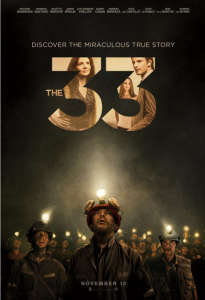November 16th, 2015 — 7:32am
 ***
***
The 33-sp
Deep Down Dark by Hector Tobar, the story of the 2010 Chilean Mine disaster and the 33 miners trapped underground, was one of the best books we have read in a long time (see book review). So a movie following in its footsteps has big shoes to fill. Director Patricia Riggen and the producing team led by veteran producer Mike Medavoy did a pretty good job of capturing the atmosphere as well as creating the tension and interaction of the beleaguered miners. They chose to make this film in English, which took away from the realism but we understand the reasonable necessity to do this to facilitate worldwide distribution. Much of the film was deep in the dark mine and the faces of the characters were understandably in deep shadows. While good for realism, it did take awhile for the characters to be clearly distinguished as individuals.
There was one interesting issue which we wonder if it was fact or creative license. That was when Laurence Golbourne (Rodrigo Santoro), the young government official who was Minister of Mines for the Chilean government told the veteran mine rescue expert exactly how he should position the last chance drilling effort, which was the only drill to reach the miners. Just as important as the interaction of the miners with each other was the role of the families putting pressure on the various officials to make an all-out effort to save their loved ones. The emotions of these family members, friends and one mistress was highlighted by the character of Maria Segovia, sister of one of the miners, who was well-played by Juliette Binoche. Another standout was the character of Mario Sepulveda (Antonio Banderas) who assumed the leadership role of the trapped miners.
This was the last film of the late James Horner who as usual created an excellent soundtrack to capture the changing moods of the film. At the conclusion of the movie, we see a postscript telling us that none of the miners received any compensation from the mine company. In a post screening discussion, we were able to ask producer Michael Medavoy if this film is financially successful, would the miners receive any compensation. The answer was, “You bet,†but it has to come after all the backers of the film receive their upfront money back plus a reasonable profit. We thought that why should the miners not receive their compensation upfront? But that apparently is the usual Hollywood way. Despite this concern, the film itself, while not meeting the standards of the amazing book is still worthwhile and should be seen and enjoyed by many viewers. Shortly after the actual disaster occurred I also wrote two blogs about the psychological implications of this experience ( see blog#1  and blog #2 ) (2015)
Comment » | 3 Stars, Drama, History
January 24th, 2013 — 8:44pm
****
No- sp
This Chilean movie was one of 90 foreign films submitted by various countries as an entry for an Academy Award. It is the first film from Chile to become one of the five finalist for an Oscar in this category which will be awarded in about one month from the date that this review is being written. This is the second film directed by Pablo Larrain to be entered by Chile for an Academy Award. The other film was Tony Mannero in 2008. No is a dramatization of a very important event that happened Chile 1988 , about which we would guess most Americans might only have the vaguest notion. That was the plebiscite in which the Chilean people were given the opportunity, because of international pressure put on long term President and dictator Augusto Pinochet, to vote whether they wanted him to continue for another 8 years. Pinochet had been an army general who was part of the coup d’etat that had overthrown the government of Salvadore Allende in 1973 and subsequently ruled the country as an appointed dictator President. His government was known for killing, interning and torturing thousands of Chilean citizens who resisted his rule. Therefore it was a big event when this election, which was under international scrutiny, was scheduled to take place where a yes or no vote would determine whether Pinochet would stay in place. The story line follows Rene Saavedra (Gael Garcia Bernal) who is a skilled advertising executive who becomes one of the masterminds behind the “ No “ campaign. Each side is given 15 minutes per day on television to make its case and the actual 1980s commercials from each side which were shown in that election were used in the film. In fact 1/3 of the movie is actual archival tapes which is weaved into the scripted segments. This probably included some of the brutal street scenes where Pinochet’s thugs and police were roughing up protesters. 1980 cameras were used to shoot the movie to capture the texture of the times. The movie showed the anxiety, drama and fear of the NO advertising team as they made their decision to emphasize what they thought would be a new day for Chile (with song and dance) as compared to all out attack on the existing government (although they did some of that also). On one hand this was an exciting battle with a dramatic ending but it also highlighted the subtle emotions with which these people struggled. We learned that many of the small but powerful roles of the characters on both sides of this struggle were played by the actual people who had been part of the No supporters 25 years ago . This gave our movie experience an added touch of authenticity. (2012)
Comment » | 4 Stars, Drama, Foreign, History





